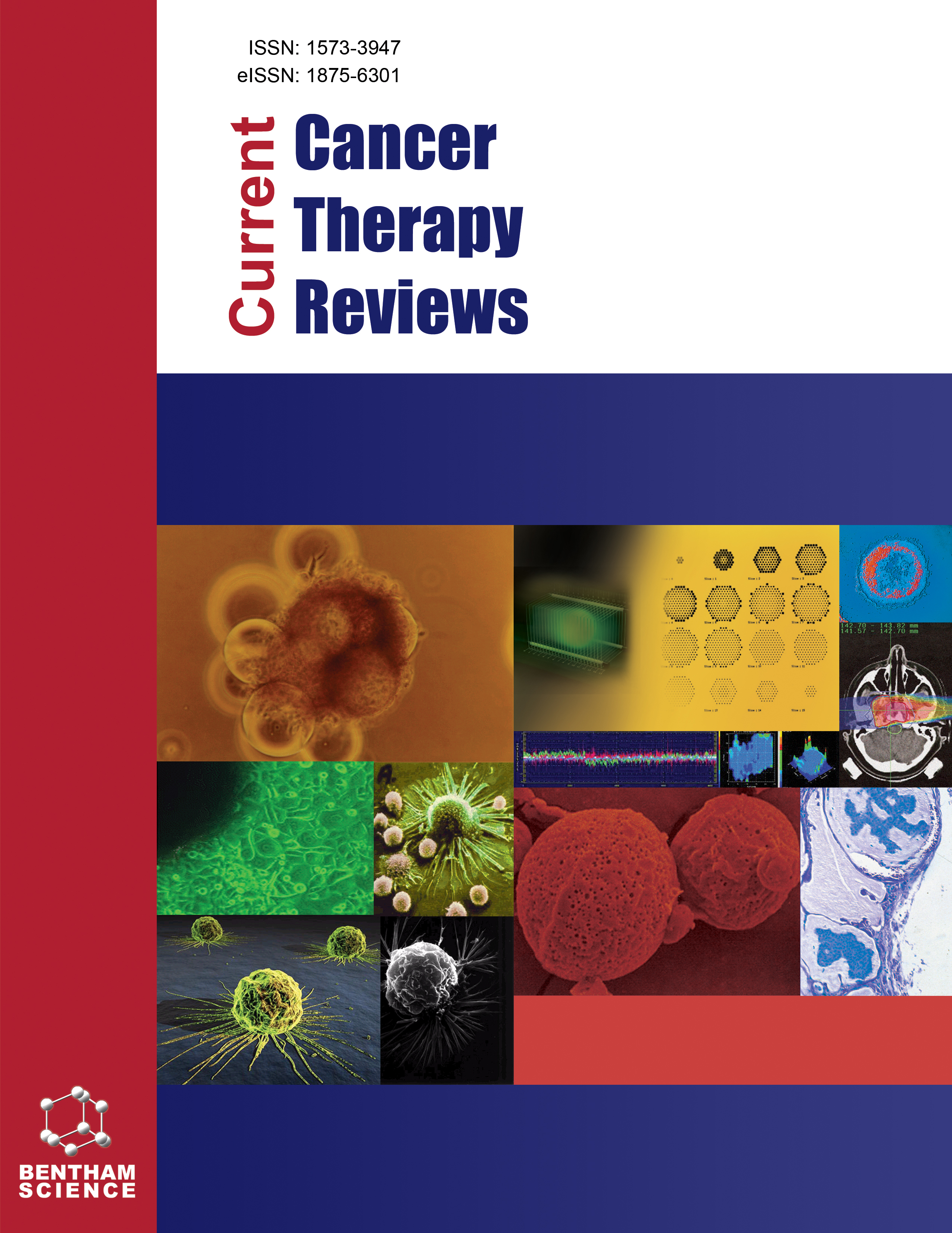- Home
- A-Z Publications
- Current Cancer Therapy Reviews
- Previous Issues
- Volume 6, Issue 1, 2010
Current Cancer Therapy Reviews - Volume 6, Issue 1, 2010
Volume 6, Issue 1, 2010
-
-
IP6 in Cancer Therapy: Past, Present and Future
More LessAuthors: Agata Matejuk and Abulkalam ShamsuddinInositol hexaphosphate (IP6) and its derivatives are naturally occurring, most abundant polyphosphorylated carbohydrates in organisms as diverse as yeast, endo-parasites, mammals and plants. IP6 represents a major metabolic pool in cellular phosphate pathways involved in vital functions such as signal transduction, regulation of cell proliferation and differentiation, RNA export, DNA repair, energy transduction and ATP reg Read More
-
-
-
Clinical Update: Treatment of Glioblastoma Multiforme with Radiolabeled Antibodies that Target Tumor Necrosis
More LessGlioblastoma multiforme (GBM) is one of the most intractable cancers in humans, and yet, in the past decade, incremental advances in the treatment of brain tumors have begun to suggest that effective therapies may be on the horizon. Here we review the latest treatments available to patients and focus on a promising radiotherapeutic strategy that employs the isotope 131Iodine conjugated to an antibody that binds th Read More
-
-
-
Liver-Directed Regional Therapy in the Multi-Disciplinary Management of Hepatocellular Cancer
More LessAuthors: Maheswari Senthil, Brian Mailey, Lucille Leong, Vincent Chung, Yun Yen, Yi-Jen Chen, Howard Marx and Joseph KimHepatocellular carcinoma (HCC) is a major worldwide health concern with an increasing incidence in the United States. Orthotopic liver transplantation (OLT) has been established as the gold standard for curative therapy of HCC. Because of limited organ supply and socioeconomic factors, OLT is often not a viable option. Surgical resection and ablation are also effective for providing long-term survival. However, mo Read More
-
-
-
Physiological and Molecular Role of Ranpirnase on Cancer Treatment
More LessAuthors: Intae Lee, Daehong Kim, Jihean Lee and Kuslima ShogenRanpirnase (ONCONASE®, a trademark of Alfacell Corporation), a cytotoxic amphibian ribonuclease, is known to be selectively tumoricidal against cancer cells. This article briefly summarizes in vitro and in vivo tumoricidal studies of ranpirnase. It proposes mechanisms of ranpirnase based on preclinical and clinical trials. Ranpirnase significantly inhibited oxygen consumption while demonstrating improvement in several tumor Read More
-
-
-
Regulatory T Cells and Cancer Therapy: An Old Story with a New Hope
More LessAuthors: Xinhai Zhang, Rick F. Thorne, Thomas E. Wagner and Yanzhang WeiAccumulating evidence indicates that regulatory T cells (Treg) are a distinct group of immune cells that are essential in maintaining immunologic homeostasis, largely by their ability to suppress responses mediated by other populations of immune cells. In a microbial infection, this suppressive function can be temporally overridden via different mechanisms so that the immune system can mount efficient antimicrobial immunity. Read More
-
-
-
MicroRNA-21 as a Novel Therapeutic Target
More LessAuthors: Mohit Sachdeva, Shoumin Zhu and Yin-Yuan MoMicroRNAs (miRNAs) are a class of naturally occurring small non-coding RNAs that control gene expression at the post-transcriptional level. To date, over 700 human miRNA precursors with over 1,000 mature miRNAs have been reported. miRNAs are related to, but distinct from, short interfering RNAs (siRNAs). A key difference between siRNAs and miRNAs is that siRNAs require almost identical sequences to targets to exert their s Read More
-
-
-
Endocrine Therapy for Advanced Breast Cancer: Beyond Tamoxifen and Aromatase Inhibitors
More LessAuthors: Angel Guerrero-Zotano and Franco MuggiaTreatment options for hormone-dependent advanced breast cancer (BC) have evolved from surgical oophorectomy, first proposed over a century ago. The discovery of steroid hormones, steroid hormone receptors and the concept that inhibition of steroid biosynthesis or hormone receptor blockade prevents tumor growth, have been introduced and tested clinically. Today, the aromatase inhibitors are the current standard of Read More
-
-
-
The Potency of Refined Mouse Models: Implications for Clinical Trials
More LessMany promising anti-cancer compounds fail in the clinical phase despite extensive testing in animal models. Reasons for this failure are varied, ranging from inadequate mouse models to dosing schemes that cannot be applied in humans. The apparent shortcomings of exisiting pre-clinical studies suggests a need for improved mouse models. Furthermore, the development of an increasing number of targeted drugs require Read More
-
Volumes & issues
-
Volume 21 (2025)
-
Volume 20 (2024)
-
Volume 19 (2023)
-
Volume 18 (2022)
-
Volume 17 (2021)
-
Volume 16 (2020)
-
Volume 15 (2019)
-
Volume 14 (2018)
-
Volume 13 (2017)
-
Volume 12 (2016)
-
Volume 11 (2015)
-
Volume 10 (2014)
-
Volume 9 (2013)
-
Volume 8 (2012)
-
Volume 7 (2011)
-
Volume 6 (2010)
-
Volume 5 (2009)
-
Volume 4 (2008)
-
Volume 3 (2007)
-
Volume 2 (2006)
-
Volume 1 (2005)
Most Read This Month
Article
content/journals/cctr
Journal
10
5
false
en


